HONDA ODYSSEY 1996 Owners Manual
Manufacturer: HONDA, Model Year: 1996, Model line: ODYSSEY, Model: HONDA ODYSSEY 1996Pages: 240, PDF Size: 2.64 MB
Page 211 of 240
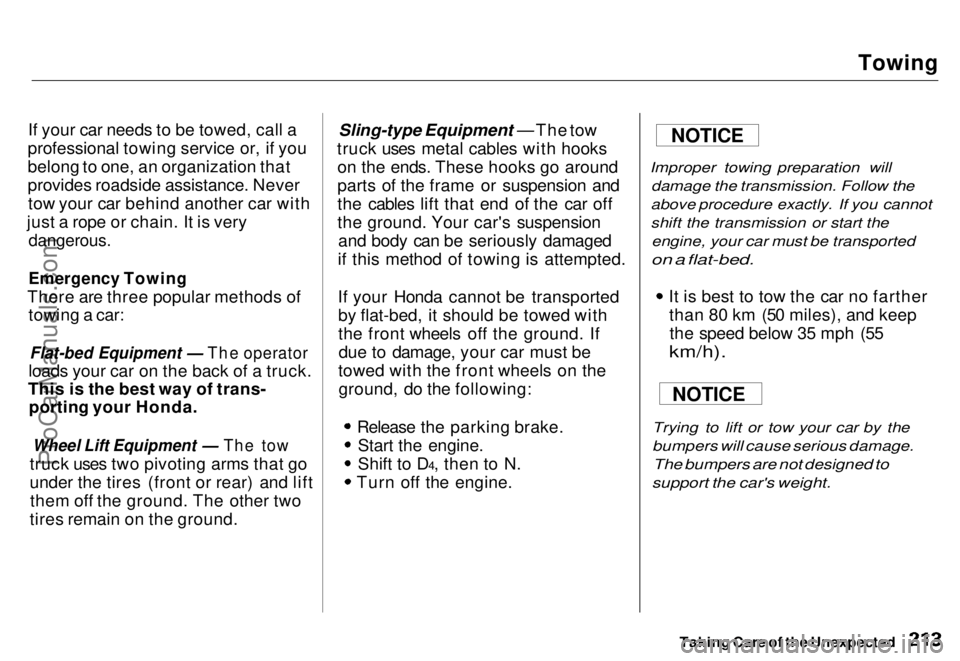
Towing
If your car needs to be towed, call a
professional towing service or, if you
belong to one, an organization that
provides roadside assistance. Never tow your car behind another car with
just a rope or chain. It is very
dangerous.
Emergency Towing
There are three popular methods of towing a car:
Flat-bed Equipment — The operator
loads your car on the back of a truck.
This is the best way of trans- porting your Honda.
Wheel Lift Equipment — The tow
truck uses two pivoting arms that go
under the tires (front or rear) and lift them off the ground. The other two
tires remain on the ground.
Sling-type Equipment — The tow
truck uses metal cables with hooks on the ends. These hooks go around
parts of the frame or suspension and
the cables lift that end of the car off
the ground. Your car's suspension and body can be seriously damaged
if this method of towing is attempted.
If your Honda cannot be transported by flat-bed, it should be towed with
the front wheels off the ground. Ifdue to damage, your car must be
towed with the front wheels on the ground, do the following:
Release the parking brake.Start the engine.
Shift to D4, then to N.
Turn off the engine.
Improper towing preparation will
damage the transmission. Follow the
above procedure exactly. If you cannot
shift the transmission or start the engine, your car must be transported
on a flat-bed.
It is best to tow the car no fartherthan 80 km (50 miles), and keepthe speed below 35 mph (55
km/h).
Trying to lift or tow your car by the
bumpers will cause serious damage.
The bumpers are not designed to
support the car's weight.
Taking Care of the Unexpected
NOTICE
NOTICEProCarManuals.comMain Menu s t Table of Contents
Page 212 of 240
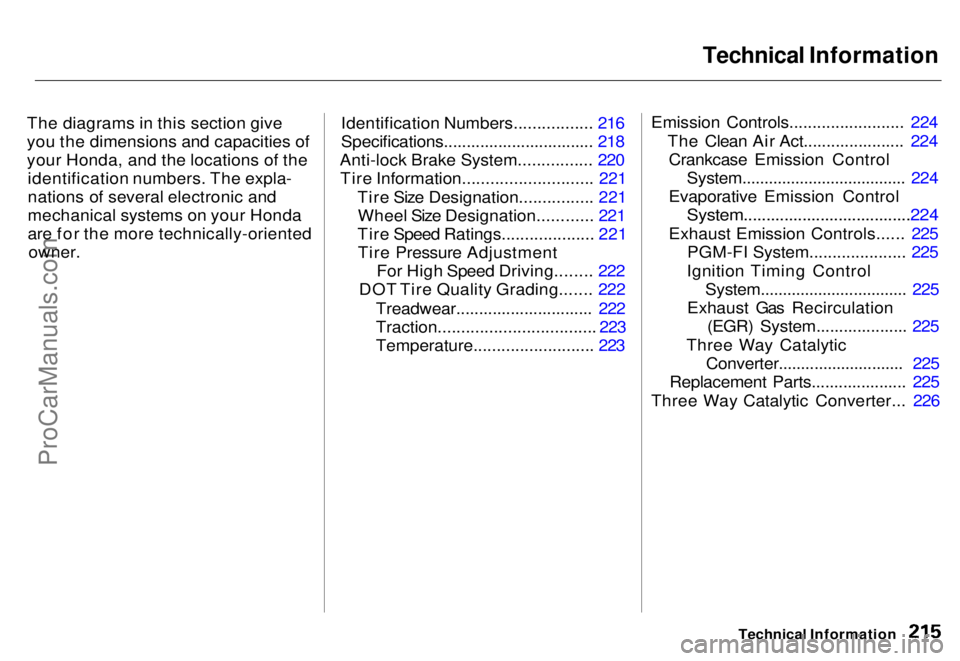
Technical Information
The diagrams in this section give
you the dimensions and capacities of
your Honda, and the locations of the identification numbers. The expla-
nations of several electronic and
mechanical systems on your Honda
are for the more technically-orientedowner. Identification Numbers................. 216
Specifications................................. 218
Anti-lock Brake System................ 220 Tire Information............................ 221
Tire Size Designation................ 221Wheel Size Designation............ 221
Tire Speed Ratings.................... 221 Tire Pressure Adjustment For High Speed Driving........ 222
DOT Tire Quality Grading....... 222
Treadwear.............................. 222
Traction.................................. 223
Temperature.......................... 223 Emission Controls......................... 224
The Clean Air Act...................... 224Crankcase Emission Control System..................................... 224
Evaporative Emission Control
System.....................................224
Exhaust Emission Controls...... 225 PGM-FI System..................... 225
Ignition Timing Control System................................. 225
Exhaust Gas Recirculation (EGR) System.................... 225
Three Way Catalytic Converter............................ 225
Replacement Parts..................... 225
Three Way Catalytic Converter... 226
Technical InformationProCarManuals.comMain Menu s t
Page 213 of 240
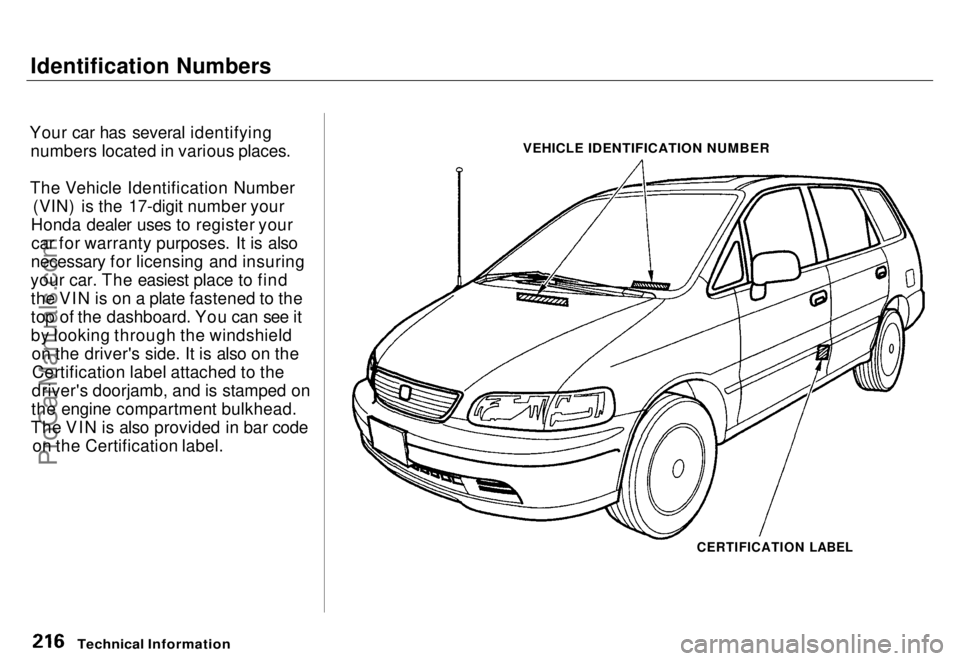
Identification Numbers
Your car has several identifying numbers located in various places.
The Vehicle Identification Number (VIN) is the 17-digit number your
Honda dealer uses to register your car for warranty purposes. It is also
necessary for licensing and insuring
your car. The easiest place to find the VIN is on a plate fastened to the
top of the dashboard. You can see it
by looking through the windshield on the driver's side. It is also on theCertification label attached to the
driver's doorjamb, and is stamped on
the engine compartment bulkhead.
The VIN is also provided in bar code on the Certification label.
VEHICLE IDENTIFICATION NUMBER
CERTIFICATION LABEL
Technical InformationProCarManuals.comMain Menu s t Table of Contents
Page 214 of 240
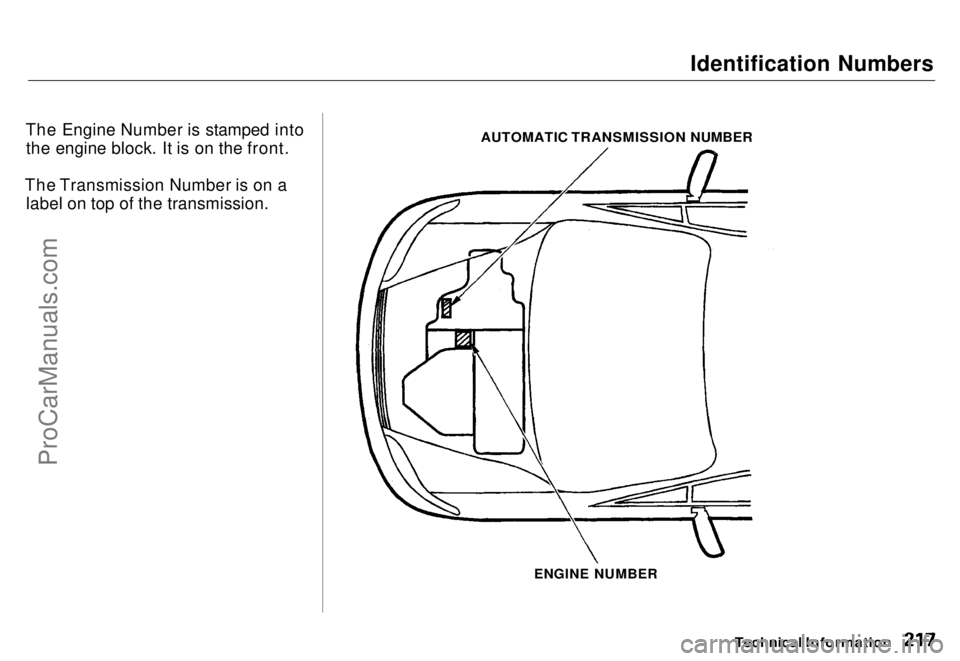
Identification Numbers
The Engine Number is stamped into the engine block. It is on the front.
The Transmission Number is on a label on top of the transmission.
Technical Information
AUTOMATIC TRANSMISSION NUMBER
ENGINE NUMBERProCarManuals.comMain Menu s t Table of Contents
Page 215 of 240
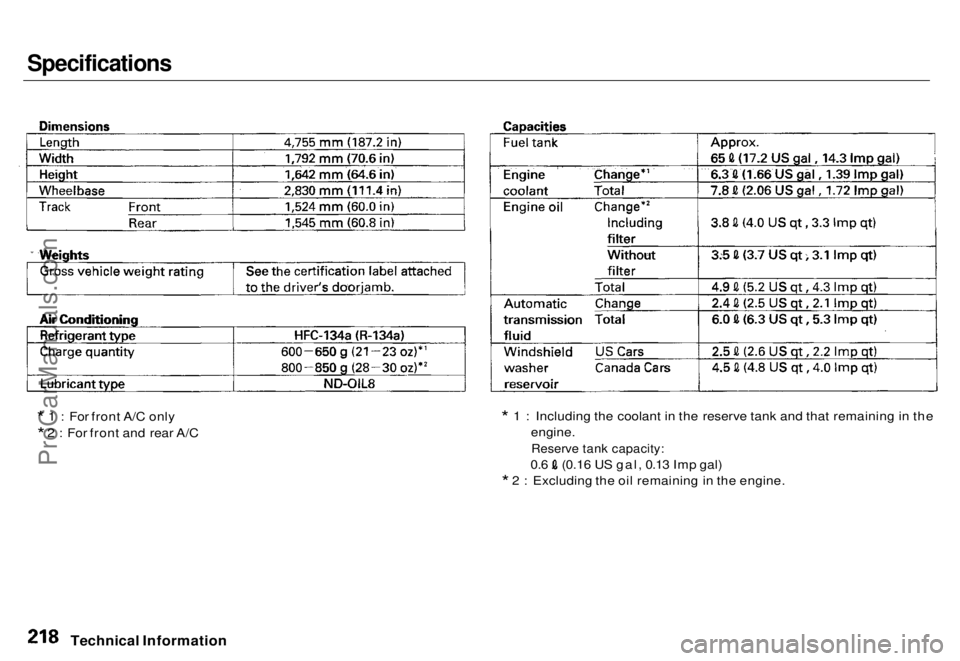
Specifications
* 1 : For front A/C only
* 2 : For front and rear A/C *
1 : Including the coolant in the reserve tank and that remaining in the
engine.
Reserve tank capacity:
0.6 (0.16 US gal, 0.13 Imp gal)
* 2 : Excluding the oil remaining in the engine.
Technical InformationProCarManuals.comMain Menu s t Table of Contents
Page 216 of 240
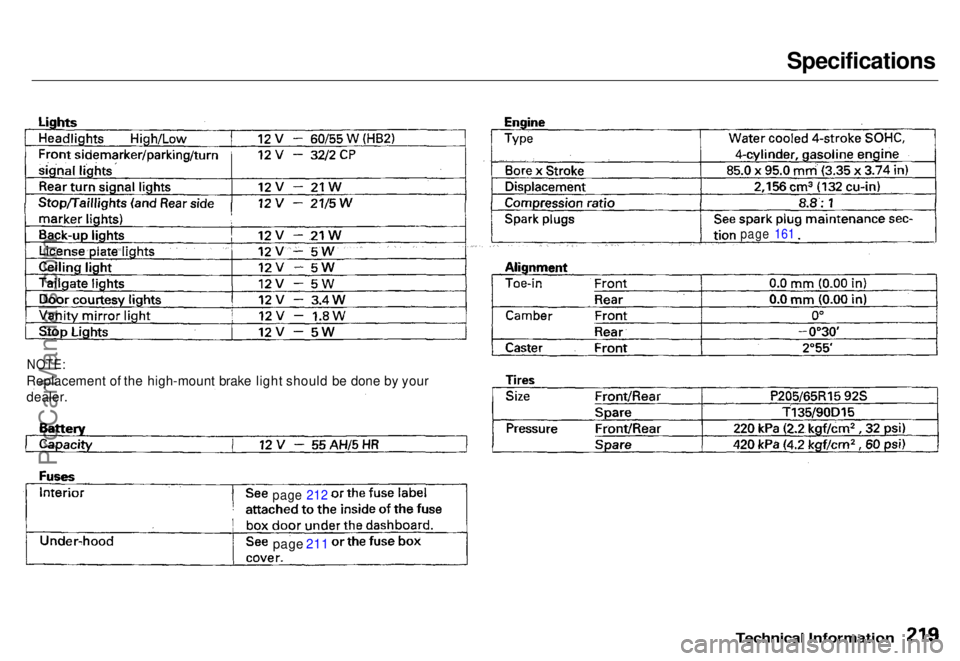
Specifications
Technical Information
NOTE:
Replacement of the high-mount brake light should be done by your
dealer.
page 212
page 211
page 161ProCarManuals.comMain Menu s t Table of Contents
Page 217 of 240

Anti-lock Brake System
The Anti-lock Brake System (ABS) is standard equipment on all U.S.
models and the Canadian six-
passenger model. It is optional on the
Canadian seven-passenger model.
The ABS works by measuring how fast the wheels are turning during
braking and comparing their speeds.
If any wheel is rotating much slower
than the others (on the verge of locking up and skidding), the systemreduces hydraulic pressure to that
wheel's brake caliper. When that wheel's speed matches the other
wheels, the system applies normal
hydraulic pressure. This can take
place several times per second at
each wheel. You feel the ABS
working as rapid pulsations in the
brake pedal.
Each wheel has a wheel speed
sensor assembly. As the wheel
rotates, the sensor sends electrical pulses to the ABS control unit. The
pulse frequency varies with the
wheel speed.
The electrical output of the ABS control unit is connected to the
modulator/solenoid unit. During
braking, the ABS control unit monitors the pulse frequencies from
the four wheels. When the control unit detects a wheel locking up, itenergizes the appropriate solenoid in
the modulator/solenoid unit. There are six solenoids: two for each front
wheel, and two for the rear wheels.
The energized solenoid reduces hydraulic pressure to one side of amodulator valve. This, in turn,
reduces hydraulic pressure in the
brake line going to the affected
wheel. When that wheel speeds up because of the reduced braking effort, the control unit de-energizes the solenoid. This builds hydraulic
pressure on the modulator valve.
The pressure increases in the hydraulic line to the wheel.
For the system to react quickly, the
modulator/solenoid unit must have
brake fluid under high pressure.
This is supplied by a piston-type accumulator that is pressurized by
an electric pump. A pressure-sensingswitch on the accumulator controls
this pump.
The control unit also contains error detection circuitry. It monitors the
operation of the wheel sensors,solenoids, pump, and electronics. If
the control unit detects any faults, it shuts off power to the pump motor
and solenoids, disabling the ABS.
The indicator on the instrument panel comes on. The brakes then
work like a conventional system
without anti-lock capabilities.
Technical InformationProCarManuals.comMain Menu s t Table of Contents
Page 218 of 240
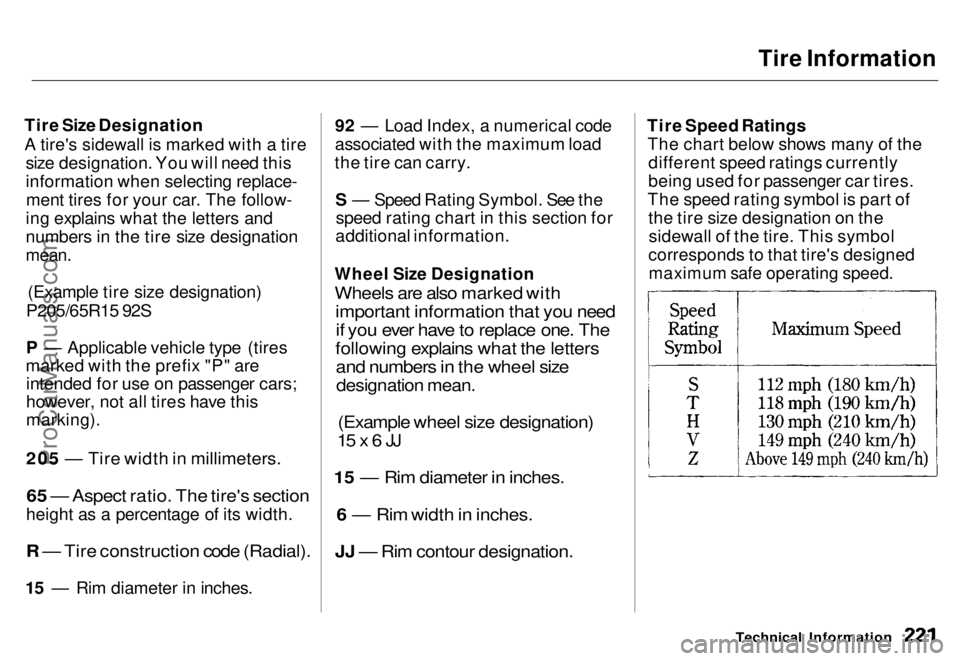
Tire Information
Tire Size Designation
A tire's sidewall is marked with a tire size designation. You will need this
information when selecting replace-ment tires for your car. The follow-
ing explains what the letters and
numbers in the tire size designation
mean.
(Example tire size designation)
P205/65R15 92S
P — Applicable vehicle type (tires
marked with the prefix "P" are intended for use on passenger cars;
however, not all tires have this
marking).
205 — Tire width in millimeters.
65 — Aspect ratio. The tire's section
height as a percentage of its width.
R — Tire construction code (Radial).
15 — Rim diameter in inches. 92 — Load Index, a numerical code
associated with the maximum load
the tire can carry.
S — Speed Rating Symbol. See thespeed rating chart in this section for
additional information.
Wheel Size Designation
Wheels are also marked with important information that you needif you ever have to replace one. The
following explains what the letters and numbers in the wheel size
designation mean.
(Example wheel size designation)
15
x
6
JJ
15 — Rim diameter in inches.
6 — Rim width in inches.
JJ — Rim contour designation.
Tire Speed Ratings
The chart below shows many of the different speed ratings currently
being used for passenger car tires.
The speed rating symbol is part of the tire size designation on thesidewall of the tire. This symbol
corresponds to that tire's designed
maximum safe operating speed.
Technical InformationProCarManuals.comMain Menu s t Table of Contents
Page 219 of 240
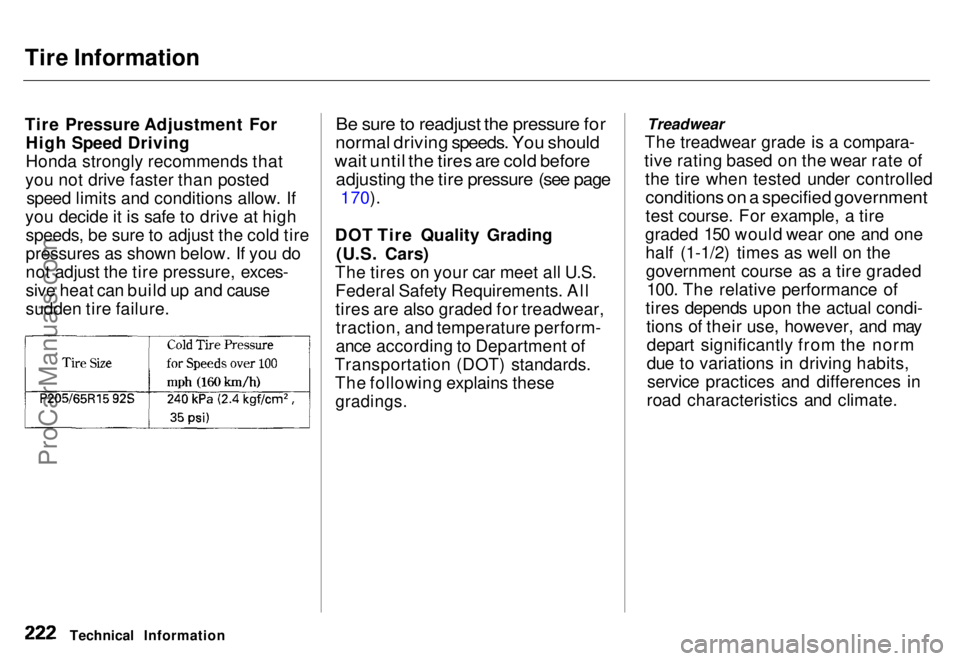
Tire Information
Tire Pressure Adjustment For
High Speed Driving
Honda strongly recommends that
you not drive faster than posted speed limits and conditions allow. If
you decide it is safe to drive at high speeds, be sure to adjust the cold tire
pressures as shown below. If you do
not adjust the tire pressure, exces-
sive heat can build up and cause
sudden tire failure.
Be sure to readjust the pressure for
normal driving speeds. You should
wait until the tires are cold before adjusting the tire pressure (see page
170).
DOT Tire Quality Grading (U.S. Cars)
The tires on your car meet all U.S. Federal Safety Requirements. All
tires are also graded for treadwear,traction, and temperature perform-
ance according to Department of
Transportation (DOT) standards. The following explains these
gradings.
Treadwear
The treadwear grade is a compara-
tive rating based on the wear rate of the tire when tested under controlled
conditions on a specified government
test course. For example, a tire
graded 150 would wear one and one half (1-1/2) times as well on thegovernment course as a tire graded 100. The relative performance of
tires depends upon the actual condi- tions of their use, however, and maydepart significantly from the norm
due to variations in driving habits,service practices and differences in
road characteristics and climate.
Technical InformationProCarManuals.comMain Menu s t Table of Contents
Page 220 of 240

Tire Information
Traction
The traction grades, from highest to lowest, are A, B, and C, and they
represent the tire's ability to stop on
wet pavement as measured under controlled conditions on specified
government test surfaces of asphalt and concrete. A tire marked C may
have poor traction performance.
Warning: The traction grade as- signed to this tire is based on brak-
ing (straight ahead) traction tests and does not include cornering (turning) traction. Temperature
The temperature grades are A (the highest), B, and C, representing the
tire's resistance to the generation of
heat and its ability to dissipate heat
when tested under controlledconditions on a specified indoor
laboratory test wheel. Sustained high
temperature can cause the material of the tire to degenerate and reduce
tire life, and excessive temperature can lead to sudden tire failure. The
grade C corresponds to a level of
performance which all passenger car
tires must meet under the Federal Motor Vehicle Safety Standard No.109. Grades B and A represent
higher levels of performance on the laboratory test wheel than theminimum required by law. Warning: The temperature grade for
this tire is established for a tire thatis properly inflated and not over-
loaded. Excessive speed, underinfla-
tion, or excessive loading either separately or in combination, can
cause heat build-up and possible tire
failure.
Technical InformationProCarManuals.comMain Menu s t Table of Contents